In the fast-paced world of social media, short-form video content dominates engagement and reach. Top creators and brands consistently publish dozens of clips from their long-form content, often powered by entire teams of editors working non-stop. But what if you could achieve the same volume and quality of clips with a single AI-driven system? This article walks you through building an automated workflow using n8n and Vizard.ai that transforms any YouTube video into multiple viral-ready clips optimized for TikTok, Instagram, and YouTube Shorts.
If you're interested in automating your content creation process and want to access the full automation template featured here, consider joining our free AI Automation Community. There, you can download this workflow and many more templates to jumpstart your AI-powered projects.
Why Automate Video Clipping?
Short-form videos are incredibly effective for capturing attention and driving engagement across social platforms. The challenge is that manually clipping long videos into multiple short clips is time-consuming and resource-intensive, often requiring dedicated editors. Automation allows you to:
- Save time by generating clips automatically
- Maintain consistent quality with AI-powered editing
- Scale your content output without increasing your team size
- Optimize clips with hooks, captions, and cuts tailored for each platform
With the right tools and setup, you can compete with larger creators and brands by producing viral clips at scale without the need for manual intervention.
Overview of the Automation Workflow
The core of this system is an integration between n8n, an open-source workflow automation tool, and Vizard.ai, an AI-powered video clipping platform. The process works as follows:
- You input a YouTube video URL into a form.
- n8n sends this URL to Vizard.ai via their API to analyze and generate viral clip suggestions.
- The system polls Vizard.ai to check the status of the video processing.
- Once clips are ready, n8n filters out the best clips based on virality scores.
- The top clips are shared in a Slack channel for review and download.
This workflow can handle long videos — even 40-minute podcasts — and return multiple clips optimized for social media sharing.
Setting Up the Workflow Trigger
The automation begins with a simple form trigger inside n8n. This form includes a single required field where you paste the YouTube video URL you want to clip. The form trigger then passes this URL into the workflow, activating the process.
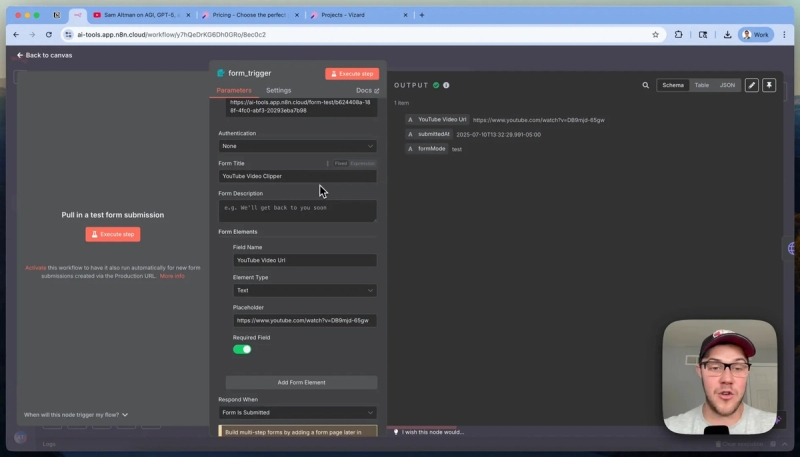
This approach makes it easy to start the clipping process with minimal input and no technical complexity.
Integrating with Vizard.ai API
Vizard.ai is the AI tool responsible for analyzing the video and generating the clips. It offers an affordable creator plan at $29 per month, which includes 600 upload minutes—covering the length of videos you can process. One of the key reasons to choose Vizard.ai is its robust API support, which allows full automation without manual uploads or downloads.
To connect n8n with Vizard.ai, you need to:
- Obtain your API key from the Vizard.ai dashboard under the Account API section.
- Create an API credential in n8n that includes this key in the request header for authentication.
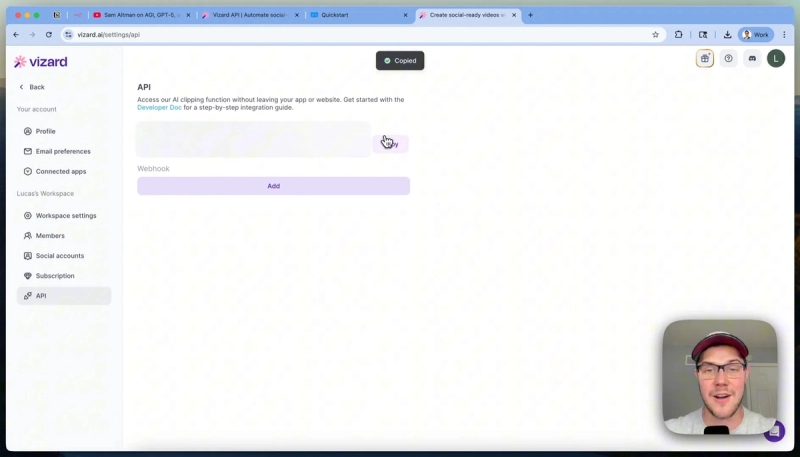
With this setup, every API request sent from n8n to Vizard.ai will be properly authenticated.
Submitting the YouTube Video for Clipping
The next step in the workflow is constructing the API request to submit the YouTube video URL for analysis. This is done via an HTTP POST request with a JSON body containing parameters such as:
- video_url: The YouTube video URL from the form input
- video_type: Set to 2, indicating a YouTube video
- prefer_length: An array that lets Vizard.ai auto-determine optimal clip lengths
- max_clip_number: Limits the number of clips generated (e.g., 8 clips)
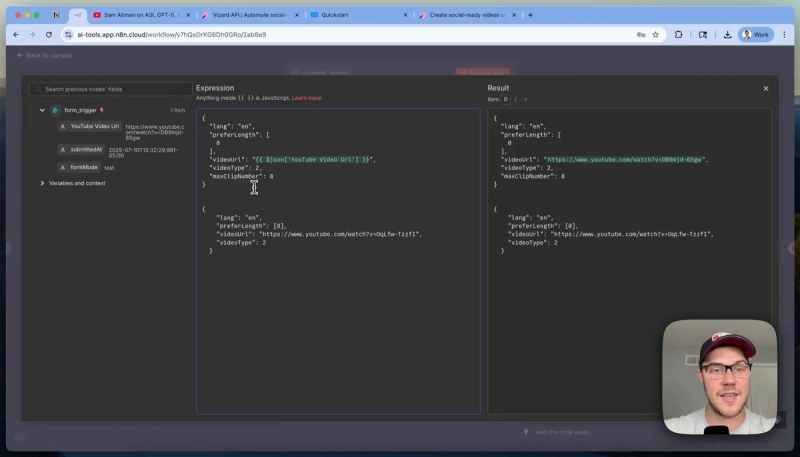
You can customize these parameters to fit your needs by consulting Vizard.ai’s API documentation. For example, you can specify preferred clip lengths or request different video types.
Polling for Clip Processing Status
Because video processing takes time—especially for longer videos—the workflow employs a polling mechanism. This means n8n repeatedly sends a GET request to Vizard.ai’s status endpoint to check whether the clips are ready.
The polling loop works like this:
- Send a GET request with the project ID received from the initial submission.
- Check the status code in the response:
- 1000: Processing ongoing, keep waiting.
- 2000: Processing complete, clips are ready.
- If processing is ongoing, the workflow waits 10 seconds, then repeats the check.
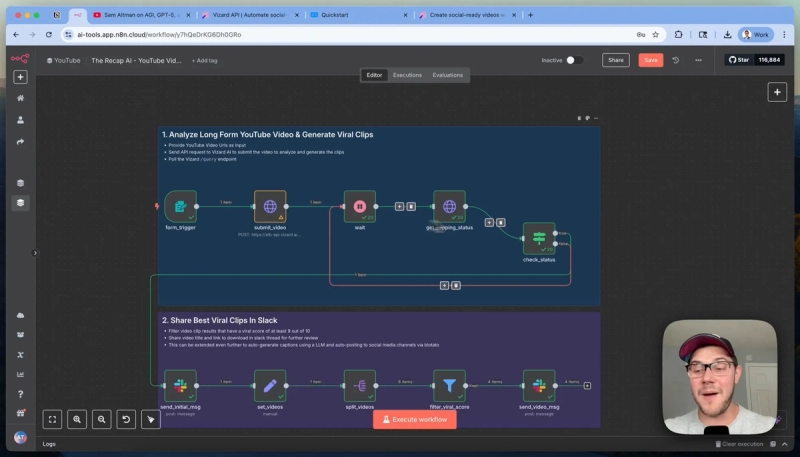
This loop continues until the clips are fully processed, ensuring the workflow proceeds only when results are ready.
Analyzing and Filtering Clips
Once the clips are ready, Vizard.ai returns an array of video clip data. Each clip includes:
- A virality score from 0 to 10 (10 being the highest potential to go viral)
- A download URL for the clip
- A transcript of the clip
- Metadata such as suggested title, caption, and reasons why the clip is likely to perform well
To maximize impact, the workflow filters clips to only keep those with virality scores of 9 or above. This ensures that only the most promising clips are surfaced for sharing.
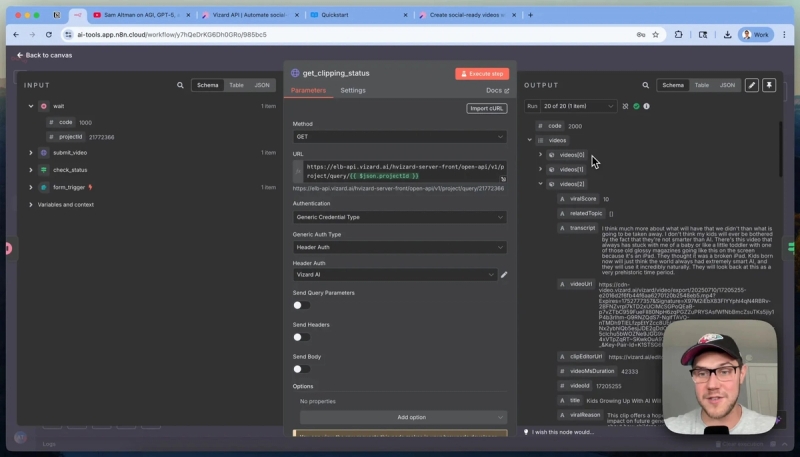
Sharing Results for Review
The final step in the workflow sends the filtered clips to a Slack channel where you can review them quickly. The automation posts each clip with:
- The clip title
- The virality score
- A direct download link to the video file
This setup helps content teams or creators instantly access their best clips without needing to dig through raw data or manually download files from Vizard.ai.
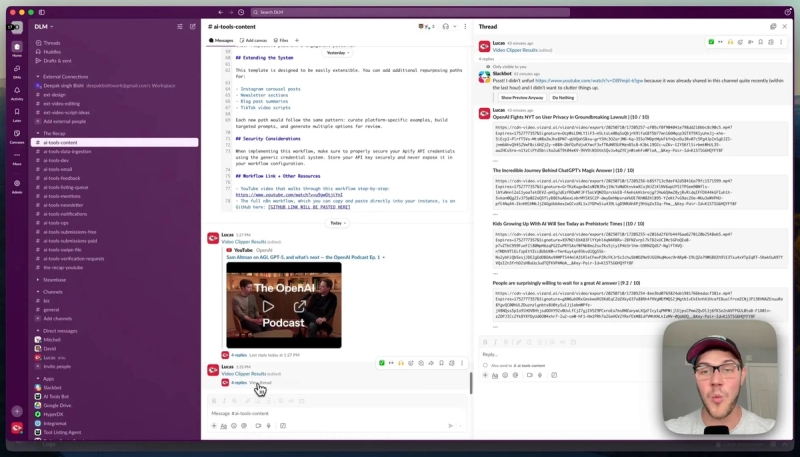
Benefits of This Automated Clipping System
This AI-powered clipping system offers several advantages:
- Speed: Quickly generate multiple clips from long videos without manual editing.
- Quality: Clips come with captions, subtitles, and camera view switches for polished presentation.
- Efficiency: Automate tedious manual clipping tasks, freeing time for content strategy and creation.
- Scalability: Handle videos of varying lengths and volumes by adjusting API parameters and plan limits.
- Platform Optimization: Clips are formatted for TikTok, Instagram, and YouTube Shorts, ensuring maximum reach.
Conclusion
Automating the creation of viral video clips from long YouTube content is now accessible using AI tools like n8n and Vizard.ai. This workflow empowers creators and marketers to produce high-quality, optimized clips at scale, saving time and effort. By focusing on clips with the highest virality scores, you ensure your social media shares have the best chance to perform well.
Ready to build your own AI-powered clipping system? Join our AI Automation Mastery community for free access to this workflow and many more automations designed to streamline your content process and business operations.





